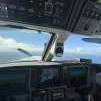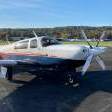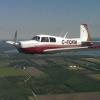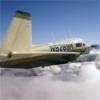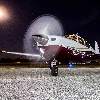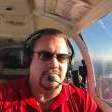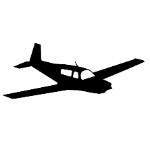Leaderboard
Popular Content
Showing content with the highest reputation on 05/13/2016 in all areas
-
One year, three months, one nerve damaged left arm, one annual, one job, and many AMUs after I purchased N79338 I finally did my first ever solo flight (in any aircraft) in my own aircraft. I'd like to thank the mooneyspace community for the advice and discouragement (some encouragement too) that I got when I first came here wondering if such a thing as I have just done was possible. I can't say I would recommend going about things this way to anyone else, nor do I regret it! The year and three months and the twenty minutes of solo flying were both a heck of a ride! I'm terribly excited to finish my PPL and arrive at my next fly in from above the horizon!14 points
-
I don't think this is a legit WW2 poster. The United States Air Force didn't come into being until September 1947. Until then, it was the USAAF (United State Army Air Force). It is interesting to see a P-38 on the poster and the reference to the Canadians.4 points
-
One: disengaging your gpss is incorrect. Leave it on, just hit the APP button when you are on the intercepting leg inbound. By selecting heading the autopilot loses its wind correction angle. Leaving it gpss will make the transition smoother. Two: your autopilot needs to be aligned. Take it somewhere that's qualified to do so, or call autopilots central.3 points
-
Just a quick Pirep. On Sunday, I installed a full set of Tempest finewire plugs in my C. I have been using Champion massives prior. In two years and 300 hours, I've never had a perfect Mag check. I always got a little more drop on one then the other and also a barely perceptible roughness on one rather than the other. I've got relatively new Slick mags and had replaced a couple of the Champion plugs at different times. After getting a good deal on the Fine wires from Mike (N601RX) on this forum, (thanks Mike), I decided to try the Fines. I must say, the engine purrs like a kitten now, the mag check was dead even and smooth as butter. And I've never seen all four cylinders as dead even on temperatures. We'll see how they work out over time, but I gotta say I'm VERY happy with them after the first few hours.2 points
-
Mike, maybe so. I negotiated but did not shop other shops. I wanted to be somewhere where I could drop in and inspect, interfere. I was there about every week. I hope they made money and stay in business, I go back to them for Garmin updates, IFR certifications, and anything else I need. That was only part of the labor for my new panel. It included the scope of work I listed. The Aspen is flush mounted which is probably extra compared to some installs. Total work involved 227 man hours. Design and build new panel, Aspen, 750, GMA 340, GTX 327, GDL 88, JPI EDM 930. Twin Lakes Avionics had the plane 10 weeks and had one man pretty much on it full time. OTOH, I've had zero glitches, zero call backs after 3-1/2 years.2 points
-
Sounds like he is at a shop that is willing to be held responsible for their actions. There are indeed circumstances where a remote annunciator would be required by regulation. I am not going to comment on whether or not this particular instance requires one or not unless you want to bring the plane to my shop and let me make that determination. But, condemning the installer for following the installation instructions is not the right thing to do.2 points
-
Solo XC i will want more approach work; Most of the time i dont know where we are going until my CFI shows up at the plane. So i dont have time to review sectionals or airport diagrams with runway numbers. I have been creating my own list of airports with runway numbers, frequencies, traffic patterns & TPAs etc. But it would be nice to do somem flight planning so that i dont show up at the airport and look all confused. When i do show up at airport X i have to really think where the entrance to the pattern is for what runway etc. IE we'll be 10nm out and say, ask for runway 25R. Then i have to think 25R? so if Im heading towards the airport at 90 and the runway runs 250 and you have to enter on on the 45, which means enter in at 205 the 25 R is a right pattern but im on the other side which means i have to transition over the airport to enter the pattern...... its a lot to think about in 10nm including getting down to altitude, communicating with ATC, etc. If i knew where we were going prior to the flight, i could have reviewed the sectional and the airport diagram and know exactly what i am going to do before i arrive. For weather, I am really good at turning around and running away @Marcopolo your early; I keep canceling it because my CFI has to go through required topics for ground school. So i didnt want to take the test and pass then go through that material again. We have 6 more topics to get through, 3 of which are directly related to x-country. I was also advised to go through flight school again prior to the oral so that everything is fresh. I think i was a little to ambitious and got through all the ground school work early and now some of the more detailed concepts i am forgetting.2 points
-
Allow me to be the first on MS to say it.... Congrats! Way to go Conrad! Solo flight in a Mooney is really cool. X-country in a Mooney is even better. Good luck getting to the finish line. Best regards, -a-2 points
-
NotarPilot-- Try here https://youtu.be/xXvMS0prgXg for a video of last night's Webinar.2 points
-
1 point
-
Too bad your budget isn't a little higher. I was looking to upgrade my PSE 8000BT to the new PSE 450. I was hoping Mark offered a trade in program, but alas this Cheap Bast#$d was once again foiled in his attempt to save a penny.1 point
-
Well take the thing off and show us what it is or behind it, the suspense is killing me.1 point
-
Bob, was that just to install the Aspen and remove the old, or was that counting making your new panel, and installing the new 750, JPI etc? That is way too much time for a simple aspen install, based on the 3 Aspen installs I have had done.1 point
-
Agree good luck on Sunday. Also tend to agree that this seems to be a different training methodology than what most of us that did the good old FAA civilian PPL route did. There is benefit to slowly leaving the comforts of home in a relatively controlled environment (i.e. your CFI watching out for you and your preflight decision making process) prior to your DPE check. My pessimistic view would be that with the fewest number of hours that the flight school has in terms of student pilots flying solo, they are assuming the least risk exposure, and their insurance may be a bit lower as a result. All under the guise of safety that you we're making sure that you are really really really ready to go solo. The downside is that very steep learning curves occur when you are 1) learning the mechanics of flying in those fist few hours with your CFI and 2) when you are totally responsible for your own well being during solo flight. It's also valuable to be able to work on certain aspects of fine-tuning your mechanics solo after a lesson with your CFI. My opinion is that a flight school that solos its students 15 hrs prior to PPL is doing a disservice to its newly minted pilots. This approach may go out the window with part 141 schools or training academies as you'd then progress to the next stage of training or what not. But, if your goal is to accumulate experience, only having minimal solo judgement / decision making and execution before being cut loose seems like an inherently bad idea. To me it seems like the flight school is saying with all the forms, tests and pre-solo multi instructor check rides prior to solo flight that they'll hold your hand just long enough so if you fall it's not on their watch.1 point
-
good catch. I had to google it. Looks like USAF used P38s from 47-49. I guess you get the hot babes because you're so smart. [emoji3] Sent from my SM-G900V using Tapatalk1 point
-
No, you don't need to do that to fly the RNAV approach. The AP is already getting a HDG signal because that is how the GPSS signal is fed to the AP, it is fed through the HDG circuit. Command is then switched to APPR mode and the course needle when the AP couples to the approach. There is sometimes some banking or adjustment at that point because the AP goes from one nav source (the GPS/GPSS through the HDG bug) to another (the course needle on the HSI, pointing to the RWY waypoint). This still confuses me though: "When I said 15-20° left bank I actually meant the course difference it would bank to (i.e. from 135 to 115 or even less in this case, which seemed a lot to capture the virtual localizer since I was already left of the approach course line)." The picture you posted shows the aircraft already left of course, whether you look at the magenta line or at the course needle on the HSI. According to the HSI you would need to steer right to get on course. If it were just the magenta line saying the course is to the right, well fine, the line is painted in the wrong place. But what I am reading and seeing on your HSI, is that the HSI itself says the course is to the right, but then the aircraft steers left to intercept? That confuses me.1 point
-
Simple answer is yes. An IFD with the upcoming 10.2 will allow ForeFlight/Stratus users to connect to both the IFD and the Stratus at the same time. ADS-B weather and traffic will still come up on ForeFlight and flightplan edits will show on both places (IFD & ForeFlight).1 point
-
Wow...my shop did it in 2.5 days, one man in my hanger, and that included pulling out all the sandel stuff.1 point
-
I have not done formation flying in the Mooney yet, but hope to before long. Nice video. Just one comment for future consideration. In pilot training, one of the things we used to grade the lead on was wingman consideration. In your video, as flight lead, I would have instructed the wingman to rejoin on the right side to avoid looking into the sun. Same thing goes during turns. If my wingman and low angle sun were on the left, and I needed to make a left turn that would end up making my wingman stare at the sun, then as I turned through the sun (pointing at it), I would signal a crossunder to have the wingman move to the right side. They would only look at the sun for a few seconds as they passed my tail. They would end up on the right looking away from the sun. Much better than making them stare at the sun while trying to maintain position. Technique only, not procedure.1 point
-
I don't think it's the autopilot at all. I think your symptoms are due to the GDC31 gain being set too low. The GDC31 computes the bank angle it needs according to the GPS data, and uses the reference voltage from the autopilot with the gain (scale facor I think they call it) to closely match it to the HSI heading signal. IOW you may have too large of a mismatch between HSI and ap signals due to gain set incorrectly. The result is the ap cannot accurately reproduce the intercept angle to capture what the GPS is telling it to do. Your KAP 150 (I have the KFC150) will bank 30 degrees max. With the gain too low it never banks enough to intercept. Your installer may have not been familiar with the GDC31. I think you need to take it to someone who knows how to configure it properly. It's a straight forward installation. Especially so with the King HSI and ap.1 point
-
I was just reading the Canada comment and wondering what that was about. Was there some kind of Canadian cold war during the '40s?1 point
-
What he said, but he was alot more succinct. And I just checked the new plate for the RNAV 31 at GYL and I see the final approach course is now 304, so my GPS would be telling me to fly 302 or something slightly less. You get the point. The GPS final course and the magenta line are not what is on the chart.1 point
-
1 point
-
Congratulations !!! My first solo was almost exactly the same number of hours, and due to a medical issue as well. I have over 900 now..... And it keeps gettin better1 point
-
1 point
-
It's like going to puttering around the sky making lots of noise to what seems like a jet fighter would feel like to fly.... Congrats1 point
-
Congrats! If you thought flying was fun before, it gets even better now! enjoy and be safe! brad N708PJ1 point
-
Fine wire Tempests were the first change I made, within less than 15 hours, after buying this M20E. It eliminated the fouled plug issue. I've put 250 hours on since w/o even thinking about the plugs except at annual. I probably put well over 1000 hours on a set of Champion fine wires in my first '66E in the '70s & 80s. I believe.1 point
-
1 point
-
Hi Greg, I had my Champions swapped for Tempest Fine Wires at my annual and like the other Pireps you're seeing I find the engine smoother and easier to start. I'm a convert too Robert1 point
-
1 point
-
Russ, Dave/Deb have done a great job of relating the issues with us for sure. Since there are so many of us and yes safety is an issue you'd think Mooney would keep us apprised of the timeline including any progress. All we get is we know your there and we haven't forgotten you all. REALLY. Communication should be there friend at this point of procrastination. We are all in the dark.1 point
-
For you Chris $100, I get the babes though. No I'm sure we can't1 point
-
I don't have your exact combination, I have a 430AW+ KFC 200 + Icarus SAM, but they work pretty much the same. It doesn't make any difference where your HDG bug is set if the GPSS is in GPSS mode rather than HDG mode. In GPSS mode, the GPSS is sending the signal from the 430 (or in your case the 750) through the HDG bug circuit to the AP and the bug itself is disabled. As for your offset, I don't have a good answer for you, although I don't think it makes any difference. You need to switch to APPR mode before the FAF, and once coupled, the magenta line and the GPSS have nothing to do with the approach. The AP is using the RWY waypoint to set a course just as it would use the localizer to do so in an ILS. You need to set the course needle to the inbound approach course so that it can do that. The AP is then "pointing" to the end of the runway and the AP itself is keeping you on the final approach course without any help from the GPSS. The only way I could see that an offset might affect it, is this: the GPSS course you fly before the FAF is the equivalent of the HDG course you fly to intercept the localizer. So if you were doing an ILS, you would be given a course to fly to intercept the localizer, and eventually a clearance to intercept the localizer. You set the HDG bug to the intercept course, and then when cleared to intercept, you would press the APPR button and the annunciator would tell you it is ARM, in other words, it is letting the HDG bug fly the plane until intercept occurs, and then you are going to see CPLD and the HDG bug will not longer be in charge, the course needle and APPR mode will be pointing to the localizer and will be in charge. The GPSS course you fly at the beginning of an LPV serves the same function, the AP uses the signal from the GPS, through the GPSS, to intercept the final approach course, but at the final approach course the AP will couple to the approach and the GPS/GPSS signal will no longer be in charge. Assuming you correctly dialed in the final approach course, the AP will be pointing at the RWY waypoint. The only thing you might see is if the offset is too much, the aircraft may never get close enough to the final approach course to couple and will stay armed, which means the GPSS is guiding you on the final approach course which should not be the case, and it also means you will not get coupling to the glide slope. So if that is what is happening, then I would take it in to your avionics shop to have it corrected. In the meantime, you can overcome the problem by using the HDG bug to fly the intercept course without the GPSS. Either way, if the AP is able to couple to the final approach course, then it is not worth worrying about, the only thing the AP is using at that point is the RWY waypoint. Now, if the RWY waypoint itself is offset for some reason, that would be a problem. I would fly it in VMC to see if you end up at the runway, or offset from the runway by some unacceptable amount. One issue that I experienced early on was switching to APPR too late. If I make the switch after the FAF in my aircraft, sometimes the AP just won't couple even if it is on the correct final approach course. I read (I think it was a John Collins article) that this happens because the ARM function calculates and uses a closing rate to the final approach course. In other words, you are flying at some angle to the course, it calculates the rate at which you are closing to the course, and uses that to switch to CPL. And if you are already exactly on the final approach course there is no closing rate, so the AP does not know what to do and never couples. This is solved if you make sure to switch the APPR before the FAF.1 point
-
Carusoam: There is an old saying among pilots who are learning formation or have gained some experience in it. It goes like this: "If you are not sweating, you are obviously out of position." Or words to that effect. Staying in position still takes work for me. I do not have Blue Angels experience so it is not as second nature to me. When flying as anyone's wing, I do not even look at instruments unless things are very stable and I can afford it. That is the crew's job - do the scan and let me know if anything is out of place. In flying formation, the aircraft is normally set up before the takeoff roll and I leave things alone (except the gear of course). Even the governor stays at 2700 rpm from the takeoff. The only thing we play with is the throttle, the control column and the rudder pedals. For the GUMPS check (still do it three times regardless of formation or not) it is all muscle memory. Touch the fuel pump switch, touch the gear handle, touch the mixture, touch the prop - all without looking at them. Looking is reserved for the other aircraft that is flying all-too-close to me. So your first instinct about being stressful is entirely appropriate. The difference for me is that while I accept the increase in stress, it is actually less than it was when I started. Why the difference? Because now I know I can do it and do it safely. And I will fly with others that can too. Yves and I have probably gained between 25 and 30 hours of formation time over the last four years. As in all things related to flying a Mooney - practice makes the difference. We do not do as much formation flying as the Texas Wing, but I have a good feeling about going through our training every year. Have you ever considered taking the training and participating? You might surprise yourself. You already have the advantage of flying an aircraft that does not let you get away with being sloppy.1 point
-
I'm glad to read this thread, it reminds me I'm not the "new guy" anymore. I did my checkride.....a year ago today! Keep up the work, you'll be right behind me.1 point
-
1 point
-
I went to the Chino air show this weekend and was surprised that the new Mooney M10 was actually part of it. I guess Mooney being a tenant there and likely paying some money got them in the show. In between WWII warbird flyby segments, they squeezed in basically an ad for Mooney. Basically a routine anybody here, or any student pilot for that matter could have done. Just back and forth along the flight line while they told a little about the specs, purpose and future of the M10. They also described the new Acclaim Ultra, but it was not there. It was a totally out of place performance and really did seem like an ad where you where looking for the "You can skip this ad in... 3,2,1..." button. But being a Mooney fan, I was kind of excited. The plane has the new diesel engine and I can say, it really seems quiet. Maybe it was the show planes all day, or maybe they had it throttled back, but it was just a muffled Brrrrrrrr.... They would have been much better off displaying the Acclaim Ultra in high speed full throttle passes. Oh well. Anyhow, here are my crappy pictures-1 point
-
FWIW I previously had fairly new Champion plugs- massive on top, fine wires on the bottom, with <200 hours on them. They had just been cleaned, gapped, and passed in the bomb tester at annual- but the shop blew me off when I asked them to resistance test them. So I decided to pull and resistance test them myself after I got the plane back. All were way out of spec, with 6 of 8 testing open circuit. I decided to replace all with new Tempest massives (UREM37BY) and I was immediately just as pleased - perceptibly smoother starting, smoother running, no more misses at low RPM, flawlessly uniform mag checks on the ground and in the air when leaned out at cruise, holding up for my last 50hrs of using them. I realize iridium fine wires have other clear advantages (fouling resistance, LOP applications), and their longevity can offset the much higher cost. But I wonder how much of the benefit here is from getting rid of Champion plugs that develop this resistance issue, not putting in fine wires per se. Supposedly Champion has now fixed this issue, but I ain't going back to 'em.1 point
-
1 point
-
Not a direct answer to you... but we were out shooting approaches around Austin over the weekend. It was a perfect time for it with OVC 1000, rain, and some isolated convective to stay clear of. I brought along a safety pilot so I could log the approaches under the hood even if we broke out early. We were discussing how three specific items make the Mooney a very comfortable IFR machine. For me that's an WAAS GPS (530W), an HSI, and a good AP (Stec-30/alt.) There are other things that help such as an electric secondary AI, but the GPS, HSI and AP make it comfortable to fly IFR for me.1 point
-
1 point
-
Quick follow-up... I had a thoroughly enjoyable time at the clinic! It is always fun to meet new Mooney folks in person, and develop new skills. I'd recommend without hesitation that any Mooney owner give this a try, even if there is no interest in joining the Caravan!1 point
-
I used my local mechanic for my PPI and still do for all of my maintenance. He is a Mooney-trained mechanic in KPLR outside of Birmingham and has folks bring him Mooneys from all over. PM me if that would fit your bill. Since I don't know where the plane is, I am not sure if it would be closer or farther for you. John1 point
-
This is a good point.. I've learned the hard way and am currently having to remove several upgrades I did just a few years ago just so I can pursue IFR. I had STec Alt Hold only and upgraded my wing-leveler to Brittain AccuTrak (just flys a heading-no approaches etc).. Now I've decided to go for full STec 30 A/P and a few other pieces..It was kind of a waste to put just the altitude hold in when I did, as was the Accutrak w/ just the heading. Several have suggested I upgrade the Accutrak, and that's a fine option, but I still lost money in the Altitude Hold on original AccuTrak install and labor..At the time I really was content with my local VFR flights with a few VFR x-country every know and then. As time marched on I decided I wanted more utility out of my plane..I could have saved lots of $ if I had thought further down the road and future goals..Just my experience.1 point
-
Guess... often, two aluminum surfaces rubbing together will generate some oxidized aluminum particles. Add some moisture, a dark grey stripe will appear running away from the source. This is similar to a smoking rivet, only larger and not as critical. To prove this to be true or not true, remove the filter retainer clean and replace. If you clean out a lot of similar aluminum wear particles, consider using the wear resistant tape that is used on planes for this purpose. How does that sound? Reminder, I am only a PP. not a mechanic. Best regards, -a-1 point
-
This thread is a bit like smoking crack; just when I think I've kicked the habit I find myself coming back just one more time. Anyway... Like Yetti I find the "% power" thing a bit odd. My question is "what % power do you set if you have to extend your downwind leg for traffic?" At some point you have to get a "feel" for establishing a proper glidepath. I (think) flying "by the numbers" is a good thing in our Mooneys but you also have to be able to look out the windshield and determine if you're on track to intercept the runway in a good place. I've never flown a Cirrus but coming in hot and then "basically standing up in my seat with full pressure on the breaks [SIC]" doesn't sound like such a great short-field-landing technique to me. Back to the original title of the thread... I think our favorite student WILL indeed solo, but if he were in a trainer it would have already happened some time ago. Keep your chin up!1 point
-
I would also highly recommend that you take the readings from skew-T between departure and destination and curve fit a polynomial equation to properly project cloud base/tops along your route [emoji3] if that's too much trouble just screw it and go!1 point
-
Interesting that they told you EASA approval in July - I went to them for a KI300 for installation in my N-reg in July and they told me there was no chance! Their recommendation was an overhauled KI256, and they got a bit uneasy when I asked for other alternatives, although they grudgingly acknowledged that an Aspen adapter would do the job1 point



















